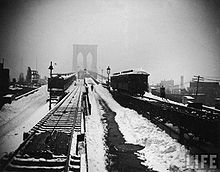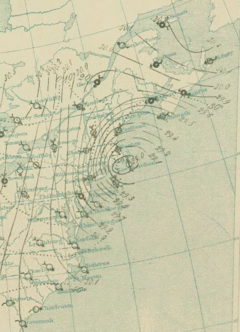- Great Blizzard of 1888
-
This article is about the blizzard in the eastern United States and Canada. For the blizzard in the Great Plains in the same year, see Schoolhouse Blizzard.
Great Blizzard of 1888 Surface analysis of Blizzard on March 12, 1888 at 10 p.m. Storm type: Winter storm Formed: March 11, 1888 Dissipated: March 14, 1888 Maximum
amount:*58 inches (147 cm) Lowest
pressure:982 hPa (29.0 inHg) Damages: $25,000,000 (1888 dollars), $1.2 billion (2008 dollars) Fatalities: 400 Areas affected: Mid-Atlantic coast ^* Maximum snowfall or ice accretion
The Great Blizzard of 1888 or Great Blizzard of '88 (March 11 – March 14, 1888) was one of the most severe blizzards in United States' recorded history. Snowfalls of 40-50 inches (102–127 cm) fell in parts of New Jersey, New York, Massachusetts and Connecticut, and sustained winds of over 45 miles per hour (72 km/h) produced snowdrifts in excess of 50 feet (15.2 m). Railroads were shut down and people were confined to their houses for up to a week.[1]
Contents
Storm details
 Streets in New York City as the storm hit. Many overhead wires broke and presented a hazard to city dwellers.[2]
Streets in New York City as the storm hit. Many overhead wires broke and presented a hazard to city dwellers.[2]
 Brooklyn Bridge during the blizzard
Brooklyn Bridge during the blizzard
The weather preceding the blizzard was unseasonably mild with heavy rains that turned to snow as temperatures dropped rapidly.[1] The storm began in earnest shortly after midnight on March 12, and continued unabated for a full day and a half. The National Weather Service estimated this incredible Nor'easter dumped 50 inches (1.3 m) of snow in Connecticut and Massachusetts, while New Jersey and New York had 40 inches (1.0 m).[3] Most of northern Vermont received from 20 inches (50.8 cm) to 30 inches (76.2 cm) in this storm.[4]
Drifts were reported to average 30–40 feet, over the tops of houses from New York to New England, with reports of drifts covering 3-story houses. The highest drift (52 feet / 15.8 metres) was recorded in Gravesend, New York. Fifty-eight inches of snow was reported in Saratoga Springs, New York; 48 inches in Albany, New York; 45 inches of snow in New Haven, Connecticut; and 22 inches of snow in New York City.[5] The storm also produced severe winds; 80 miles per hour (129 km/h) wind gusts were reported, although the highest official report in New York City was 40 miles per hour (64 km/h), with a 54 miles per hour (87 km/h) gust reported at Block Island.[5] New York's Central Park Observatory reported a minimum temperature of 6°F (-14.4°C), and a daytime average of 9°F (-12.8°C) on March 13, the coldest ever for March.[5]
Effects
The storm, referred to as the Great White Hurricane, paralyzed the East Coast from the Chesapeake Bay to Maine,[3] as well as the Atlantic provinces of Canada.[1] Telegraph infrastructure was disabled, isolating Montreal and most of the large northeastern U.S. cities from Washington, D.C. to Boston for days. Following the storm, New York began placing its telegraph and telephone infrastructure underground to prevent their destruction. From Chesapeake Bay through the New England area, over 200 ships were either grounded or wrecked, resulting in the deaths of at least 100 seamen.[5]
In New York, neither rail nor road transport was possible anywhere for days,[6] and drifts across the New York — New Haven rail line at Westport, Connecticut took eight days to clear; transportation gridlock as a result of the storm was partially responsible for the creation of the first underground subway system in the United States, which opened nine years later in Boston.[7]
Fire stations were immobilized, and property loss from fire alone was estimated at $25 million.[6] Severe flooding occurred after the storm due to melting snow, especially in the Brooklyn area, which was more susceptible to serious flooding due to its topography.[5] Efforts were made to push the snow into the Atlantic Ocean. Over 400 people died from the storm and the ensuing cold, including 200 in New York City alone.[5][8] Among them was former U.S. Senator Roscoe Conkling.
The blizzard resulted in the founding of the Christman Bird and Wildlife Sanctuary located near Delanson, Schenectady County, New York. It was listed on the National Register of Historic Places in 1970.[9]
Pictures
-
45th Street and Grand Central Depot, Manhattan, March 12
-
Park Place in Brooklyn, March 14
-
New Britain, Connecticut, March 13
Notes
- ^ a b c Douglas, Paul (2004). Restless Skies. Barnes & Noble Publishing, Inc.. pp. 12–13. ISBN 0-7607-6133-2.
- ^ "Building the invisible city". Virtual New York. http://www.vny.cuny.edu/blizzard/building/building.html. Retrieved 2007-05-10.
- ^ a b "Biggest Snowstorms in the United States: From 1888 to Present". NWS Milwaukee/Sullivan, WI. http://www.crh.noaa.gov/mkx/climate/big.php. Retrieved 2007-12-21.
- ^ "Climate of Vermont" (pdf). National Climatic Data Center. http://www5.ncdc.noaa.gov/climatenormals/clim60/states/Clim_VT_01.pdf. Retrieved 2007-12-21.
- ^ a b c d e f "The Big One! A Review of the March 12–14, 1993 "Storm of the Century" [With comparisons to the Blizzard of 1888"]. National Climatic Data Center. http://www1.ncdc.noaa.gov/pub/data/blizzard/blizz.txt. Retrieved 2007-12-21.
- ^ a b "The Blizzard of 1888; the Impact of this Devastating Storm on New York Transit". http://www.nycsubway.org/articles/1888-blizzard.html.
- ^ "Blizzard shuts down Massachusetts". Massachusetts Foundation for the Humanities. http://www.massmoments.com/moment.cfm?mid=77. "Perhaps the most important legacy of the Blizzard of 1888 was the Boston subway system. Alarmed by the paralysis and economic damage the storm caused, Boston decided to build a subway."
"The Blizzard of 1888; the Impact of this Devastating Storm on New York Transit". http://www.nycsubway.org/articles/1888-blizzard.html. "There is no overstating the significant impact this tragedy had on the metropolis, especially on transportation. The resulting standstill on the elevated lines resulted in the city adopting a plan to build subways."
- ^ "On Mar 12 in weather history". NWS Northern Indiana Weather History. http://www.crh.noaa.gov/iwx/program_areas/wxhisttdy/index.php?url=Mar12. Retrieved 2007-12-21.
- ^ "National Register Information System". National Register of Historic Places. National Park Service. 2009-03-13. http://nrhp.focus.nps.gov/natreg/docs/All_Data.html.
References
Further reading
- Borgna Brunner, "The Great White Hurricane"
- "In a Blizzard's Grasp" (PDF). The New York Times. March 13, 1888. http://query.nytimes.com/mem/archive-free/pdf?res=9C00E7D8173AE033A25750C1A9659C94699FD7CF. Retrieved 2007-12-21.
- Murphy, Jim (2006). Blizzard!: The Storm That Changed America. Scholastic. ISBN 0590673106.
External links
- Major winter storms at National Oceanic and Atmospheric Administration (NOAA)
- Images at NOAA
- Snow removal at National Snow and Ice Data Center
- Impact of the blizzard on the NYC subway
Blizzards in the United States 19th century 20th century 21st century Categories:- Blizzards in the United States
- Nor'easters
- Natural disasters in New York
- Natural disasters in New Jersey
- Natural disasters in Connecticut
- Natural disasters in Massachusetts
- Natural disasters in Washington, D.C.
- Natural disasters in Pennsylvania
- Natural disasters in Maryland
- 1888 meteorology
- 1888 natural disasters
-
Wikimedia Foundation. 2010.




